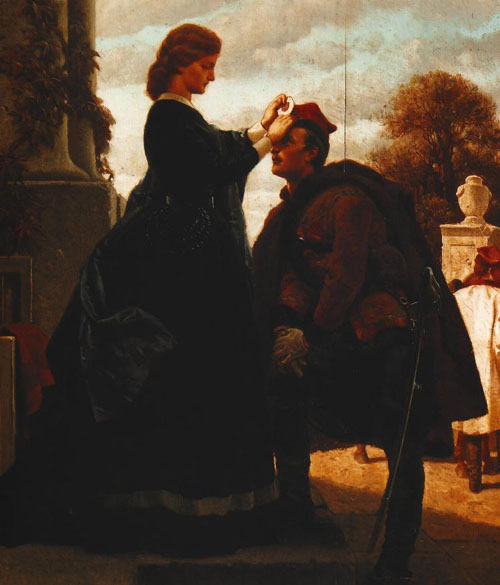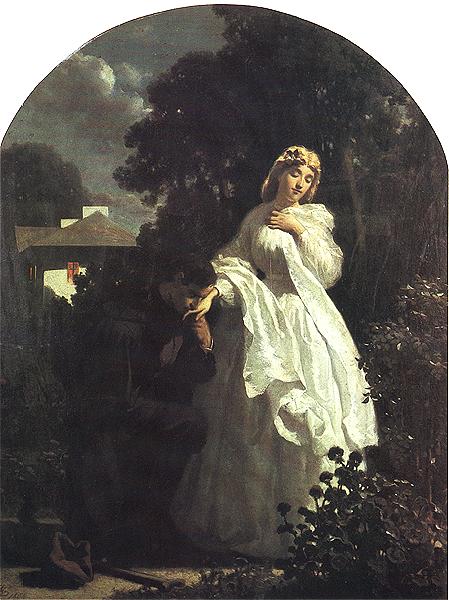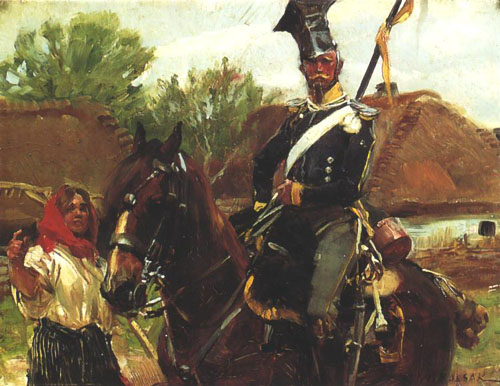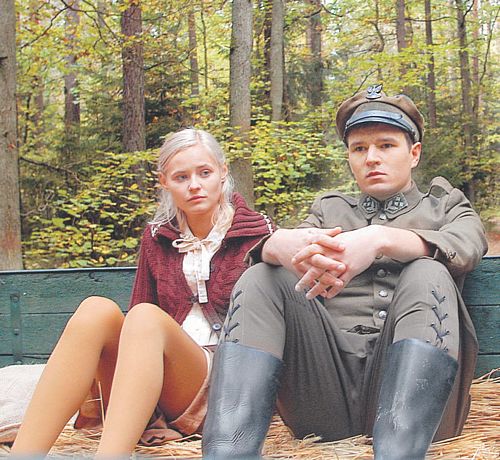|
|
Post by Bonobo on Mar 10, 2008 21:39:02 GMT 1
Michal Zebrowski played a little handsome, always correct, and a little boring Jan Skrzetuski. While Aleksander Domgarow played really handsome, wild at heart and interesting Jurko Bohun. Unfortunatelly the candy-sweet Helena played by Izabella Skorupko chose the Pole not the Kozak.  Oh, I see, so the delicate, gentlemanly, well-mannered, well-behaved Skrzetuski isn`t a proper match. You deem him boring!? You prefer this barbarian, rebellious, rough, rude, savage Bohun!!! Because he is exciting? Huh? I see. Women are known to cling to men who behave disorderly. There is certain aura of excitement around rebelious guys. Livio, you must be a typical Polish woman who have always liked Polish rebels. It was you in your former incarnations who provoked males in Poland to stand up and fight, even when the odds were totally against. The stupid naive males let women beguile them into senseless fighting. For what?? For the feminine pleasure of seeing, touching, loving a rebel? How vain! Look at your incarnations in the past: A Farewell to an Insurgent, Artur Grottger, 1866.  Welcoming an insurgent, Artur Grottger, 1865.  The ulan and the girl, Wojciech Kossak, 1925  The anticommunist partisan and the girl   |
|
livia
Just born

Posts: 121
|
Post by livia on Mar 10, 2008 21:46:54 GMT 1
Livio, you must be a typical Polish woman who have always liked Polish rebels. It was you in your former incarnations who provoked males in Poland to stand up and fight, even when the odds were totally against. Provoked? It is you who is provoking now ;D ;D ;D Pa-viah-ahn!! You can believe me - no woman wants his husband, father, son dead. You've got it all wrong! |
|
|
|
Post by Bonobo on Mar 10, 2008 21:56:38 GMT 1
Livio, you must be a typical Polish woman who have always liked Polish rebels. It was you in your former incarnations who provoked males in Poland to stand up and fight, even when the odds were totally against. Provoked? It is you who is provoking now ;D ;D ;D Pa-viah-ahn!! You can believe me - no woman wants his husband, father, son dead. You've got it all wrong! Livio, I am only applying certain dose of logic into it. hahahaha You admire Jurko Bohun. Who is Jurko Bohun?? He is a Ukrainian cossack who rebelled against his Polish masters. The film focuses on love theme, that Bohun rebels after he is denied the Polish girl whom he loves. Of course, it is a typical Hollywood trick. There wasn`t any love. Real historical Bohun rebelled because he decided to fight for independent Ukraine. He stood up and fought for a lost cause, because it was impossible to create a Ukrainian state at the time. Yet, you still admire him, despite the obvious fact that he voluntarily entered a path of destruction. By joining a hopeless fight, he endangered his life many times. Do you mean what I know now? hahahaha |
|
livia
Just born

Posts: 121
|
Post by livia on Mar 10, 2008 22:07:23 GMT 1
Provoked? It is you who is provoking now ;D ;D ;D Pa-viah-ahn!! You can believe me - no woman wants his husband, father, son dead. You've got it all wrong! Livio, I am only applying certain dose of logic into it. hahahaha You admire Jurko Bohun. Who is Jurko Bohun?? He is a Ukrainian cossack who rebelled against his Polish masters. The film focuses on love theme, that Bohun rebels after he is denied the Polish girl whom he loves. Of course, it is a typical Hollywood trick. There wasn`t any love. Real historical Bohun rebelled because he decided to fight for independent Ukraine. He stood up and fought for a lost cause, because it was impossible to create a Ukrainian state at the time. Yet, you still admire him, despite the obvious fact that he voluntarily entered a path of destruction. By joining a hopeless fight, he endangered his life many times. Do you mean what I know now? hahahaha Pah-viah-ahn ;D ;D ;D I don't admire anyone in the movies in general. Such a construction ;D ;D ;D I only said that IN THE MOVIE Jurko Bohun played by Aleksander Damagarov had the guts, was interesting and handsome. While Jan Skrzetuski played by otherwise excellent actor Michal Zebrowski was a bit flat and boring. That is all I said. And basing on that you have already constructed a plan how to defend Rzeczpospolita against Ukraiinian rebel.    ;D ;D ;D |
|
|
|
Post by Bonobo on Mar 17, 2008 21:40:57 GMT 1
Pah-viah-ahn ;D ;D ;D I don't admire anyone in the movies in general. Such a construction ;D ;D ;D I only said that IN THE MOVIE Jurko Bohun played by Aleksander Damagarov had the guts, was interesting and handsome. It is enough to talk about admiration, especially that these words are uttered by a woman about a man. Said clearly enough to realise that you rejected the guy for his boredom. Me? No? Let`s talk about it in the History Board..... |
|
|
|
Post by Bonobo on Dec 4, 2009 20:54:05 GMT 1
Men And Women May Respond Differently To Danger
Posted on: Sunday, 29 November 2009, 08:49 CST
Researchers using functional magnetic resonance imaging (fMRI) to study brain activation have found that men and women respond differently to positive and negative stimuli, according to a study presented today at the annual meeting of the Radiological Society of North America (RSNA).
"Men may direct more attention to sensory aspects of emotional stimuli and tend to process them in terms of implications for required action, whereas women direct more attention to the feelings engendered by emotional stimuli," said Andrzej Urbanik, M.D., Ph.D., chair of Radiology at Jagiellonian University Hospital in Krakow, Poland.
For the study, Dr. Urbanik and colleagues recruited 40 right-handed volunteers, 21 men and 19 women, between the ages of 18 and 36. The volunteers underwent fMRI while viewing pictures from the International Affective Picture System (IAPS), a widely used, standardized testing system comprised of several thousand slides of various objects and images from ordinary life designed to evoke defined emotional states. The images were displayed in two runs. For the first run, only negative pictures were shown. For the second run, only positive pictures were shown.
While viewing the negative images, women showed decidedly stronger and more extensive activation in the left thalamus, which relays sensory information to and from the cerebral cortex, including the pain and pleasure centers. Men exhibited more activation in the left insula, which gauges the physiological state of the entire body and then generates subjective feelings that can bring about actions. Information from the insula is relayed to other brain structures involved in decision making.
"The brain activation seen in the women might indicate stronger involvement of the neural circuit, which is associated with identification of emotional stimuli," Dr. Urbanik said. "The more pronounced activation of the insular cortex in the men might be related to the autonomic components, such as elevated heart rate or increased sweating, that accompany watching emotional material."
The autonomic nervous system controls involuntary functions, including respiration, heart rate and digestion, and helps to adjust certain functions in response to stress or other environmental stimuli. It is responsible for the body's "fight or flight" response to threatening situations.
"In men, the negative images on the slides were more potent in driving their autonomic system," Dr. Urbanik said. "This might signal that when confronted with dangerous situations, men are more likely than women to take action."
While viewing positive images, women showed stronger and more extensive activation in the right superior temporal gyrus, which is involved in auditory processing and memory. Men exhibited stronger activation in the bilateral occipital lobes, which are associated with visual processing.
Dr. Urbanik believes these differences indicate that women may analyze positive stimuli in a broader social context and associate the positive images with a particular memory. Viewing a picture of a smiling toddler might evoke memories of a woman's own child at this age. Conversely, male responses are more perceptual.
"Positive images are devoured by mens' visual and motivational systems," Dr. Urbanik said.
Co-authors are Lilianna Podsiadło, Ph.D., Michał Kuniecki, Ph.D., Justyna Kozub, M.Sc., and Barbara Sobiecka, M.Sc. Eng.
---
|
|